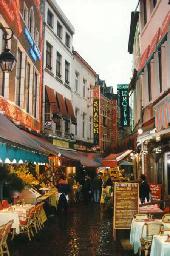The New Urbanism
The forthcoming issue of The American Conservative has a great piece by William S. Lind on the New Urbanism. Lind concedes that New Urbanism has often become the province of eco-extremists and other lovers of big government that would use coercion to enforce their ideas. But, he says, New Urbanism, properly understood and implemented, is not like that at all. The paper copy of the issue hasn't hit the newsstands yet, but when it does, it's worth checking out. Excerpts:
Central to [new urban planner] Duany's vision has been not just architectural style . . . but the reintegration of what postwar codes separated: where people live, shop, and work. Ideally, these should all be within walking distance. Not only is that efficient, it creates something cultural conservatives prize highly: community. Community is good in itself, in terms of the non-material richness it adds to life, but for conservatives it offers something more. Morals are enforced more effectively and less dangerously by the pressures that occur naturally within a genuine community than by the power of the state.
[G]ood New Urbanism . . . does not need the power of the state behind it. It sells very well on its own. When people are shown a good New Urbanist development, whether a greenfield new town or urban infill, they say, "Boy, wouldn't it be great to live here!" In Duany's Kentlands development in Maryland's Montgomery County, outside Washington, houses sell for a premium of $30,000 to $40,000 over the same floor space in surrounding sprawl developments.
According to the New Urbanism Website, the following are the ten principles of New Urbanism:
1. Walkability
2. Connectivity
3. Mixed-Use & Diversity
4. Mixed Housing
5. Quality Architecture & Urban Design
6. Traditional Neighborhood Structure
7. Increased Density
8. Smart Transportation
9. Sustainability
10. Quality of Life

